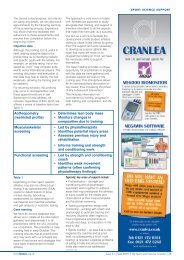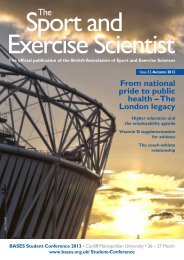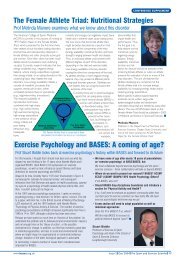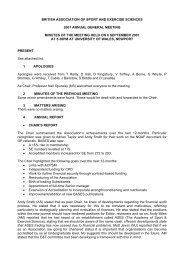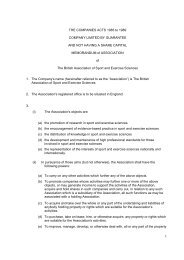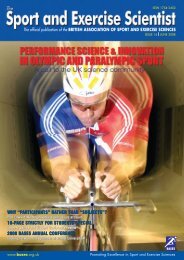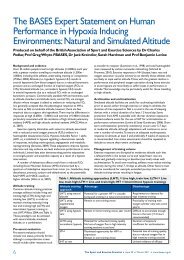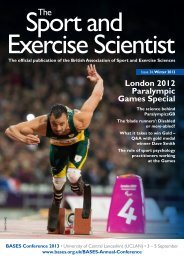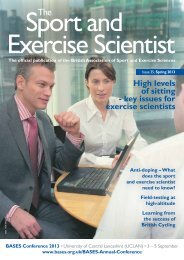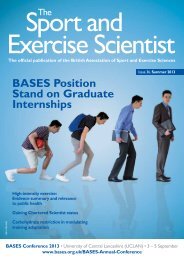Issue 31 Spring 2012 - Bases
Issue 31 Spring 2012 - Bases
Issue 31 Spring 2012 - Bases
You also want an ePaper? Increase the reach of your titles
YUMPU automatically turns print PDFs into web optimized ePapers that Google loves.
Additional input<br />
Psychological input addressed the following aspects:<br />
1. Re-evaluation of the impact of the pain stimulus on the athlete<br />
2. Enhancement of healing using neurobiological facilitation<br />
3. Re-establishing trust and confidence in using the knee<br />
Nutritional support included the following:<br />
1. Nutritional aids for tendon healing and muscle hypertrophy<br />
2. Factors influencing immunity including probiotics, zinc and<br />
vitamin C<br />
3. Given his history of stress fracture, the athlete’s vitamin D status<br />
was assessed.<br />
Strength diagnostics<br />
The force closure capacity of the athlete’s knee joint was assessed<br />
by recording isokinetic eccentric and concentric peak torque<br />
at 60°/s, 180°/s and 300°/s. The results indicated that there was<br />
appropriate neuromuscular function of the hamstrings, but a 20%<br />
discrepancy in peak torque production of the knee extensors<br />
at 60°/s velocities. To determine the functional relevance of the<br />
strength discrepancies, a single leg countermovement jump was<br />
undertaken. There was a 21% difference in jump height, 16%<br />
difference in peak force production and 27% difference in reactive<br />
strength index (jump height divided by push time). It was observed<br />
that the athlete could not control the rotation of his pelvis on<br />
his left leg as well as he could on the right, which exposed his<br />
patella tendon to greater shearing forces. The difference in jump<br />
performance and stiffening characteristics of the knee is likely<br />
to have been related to the difference in peak force production<br />
of the knee extensors. In addition, the knee extensor muscles of<br />
the injured knee had less capacity for force absorption thereby<br />
exposing the patellar tendon on that side to more stress.<br />
Observations<br />
• The left patella tendon may have been under greater strain than<br />
the right during bilateral loading tasks (e.g., squatting) as there<br />
were different force production capacities between legs<br />
• The athlete may have been exposing the patella tendon to<br />
greater shearing forces on the left leg due to the lack of hip<br />
stability when producing high forces<br />
• The athlete required greater hamstring strength on both legs to<br />
improve capacity for force closure in both knees.<br />
Training solutions<br />
• Introduction of a high load single leg strength programme using<br />
exercises that require rotation control of the hip and heavy<br />
loading of the quadriceps (e.g., Bulgarian Split Squat)<br />
• Introduce bilateral high force hamstring training (e.g., full range<br />
concentric & eccentric Nordic Curl)<br />
• Introduce exercises to improve the ability to control pelvic<br />
rotation by improving oblique strength (e.g., lateral rollouts,<br />
barbell side bends and split Pallof presses).<br />
Above: Providing optimal injury rehabilitation<br />
Courtesy Caryl Becker<br />
Stress and recovery<br />
The Rest-Q questionnaire (Kellmann & Kallus, 2001) was<br />
administered at the start and the end of the week and<br />
demonstrated an increase in perception of recovery whilst<br />
perceptions of stress reduced slightly. This showed that the athlete<br />
was in a better psychological state to continue his rehabilitation<br />
effectively.<br />
Summary<br />
The athlete completed a comprehensive week at the IRU and<br />
was discharged back to the care of his own support team with<br />
suggestions for both clinical and training strategies to continue to<br />
progress his rehabilitation. He made a full recovery.<br />
This case study highlights how long-term injury at a local site can<br />
be caused by long-term strains in other parts of the body (Myers,<br />
2009). An injury may manifest locally because of a remote inherent<br />
weakness, or a seemingly unrelated previous injury, and not solely<br />
due to local strain. Identifying these pathways with an integrated,<br />
clinically-led and scientifically-based strategy allows effective release<br />
of chronic strain and restoration of systemic function.<br />
The IRU is a collaboration between the British Olympic Association (BOA) and the English<br />
Institute of Sport (EIS) and provides residential, intensive rehabilitation to Britain’s top athletes.<br />
words: Ashleigh Wallace<br />
A former South African hockey international, Ash has worked for over 15 years with a<br />
variety of elite sports, including GB rowing & GB/England hockey and has attended both<br />
Olympic and Commonwealth Games. Ash combines her role at the IRU with being an EIS<br />
Lead Physiotherapist.<br />
Dr Anita Biswas<br />
Anita is a specialist in sports and exercise medicine and has worked with the EIS for<br />
several years. Anita was formally the Chief Medical Officer for the GB Paralympics team<br />
and has attended three Paralympic Games and a Commonwealth Games, as well as a<br />
number of World and other major championships with a variety of sports.<br />
Ben Rosenblatt<br />
Ben is a Senior Rehabilitation Scientist at the IRU with a background in strength and<br />
conditioning. He is currently undertaking a PhD in biomechanics and strength and<br />
conditioning. He has several years of coaching and sport science experience including<br />
work in the USA, professional football, rugby and Olympic sports.<br />
References<br />
Gunn, C.C. (2002). The Gunn approach to the treatment of chronic pain:<br />
intramuscular stimulation for myofascial pain of radiculopathic origin. Edinburgh:<br />
Elsevier Science.<br />
Kellmann, M. & Kallus, K.W. (2001). Recovery-stress questionnaire for athletes:<br />
user manual. Champaign, IL: Human Kinetics.<br />
Korner, M. (2010). Interprofessional teamwork in medical rehabilitation: a comparison<br />
of multidisciplinary and interdisciplinary team approach. Clinical Rehabilitaion, 745-755.<br />
Loeser, J.D. (2001). Bonica’s management of pain (3rd ed.). Lippincott Williams & Wilkins.<br />
Myers, T.W. (2009). Anatomy Trains (2nd ed.). Edinburgh: Churchill Livingstone Elsevier.<br />
The Sport and Exercise Scientist n <strong>Issue</strong> <strong>31</strong> n <strong>Spring</strong> <strong>2012</strong> n www.bases.org.uk<br />
7



